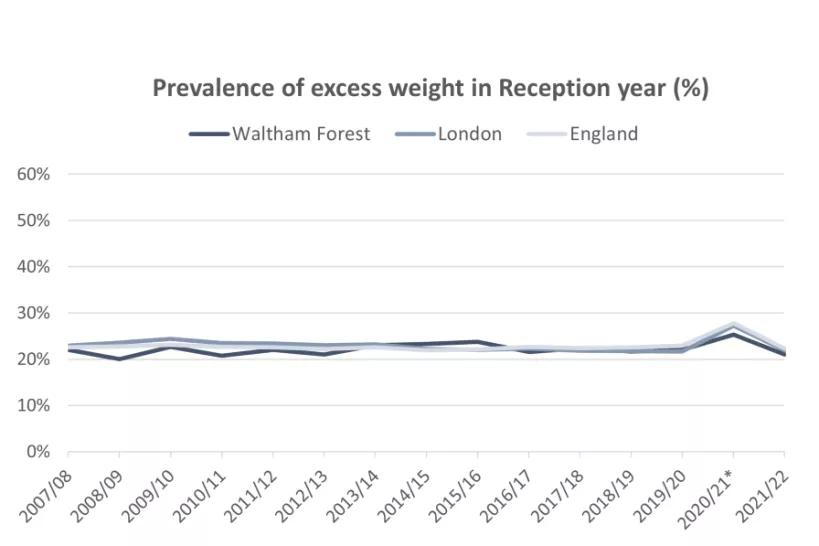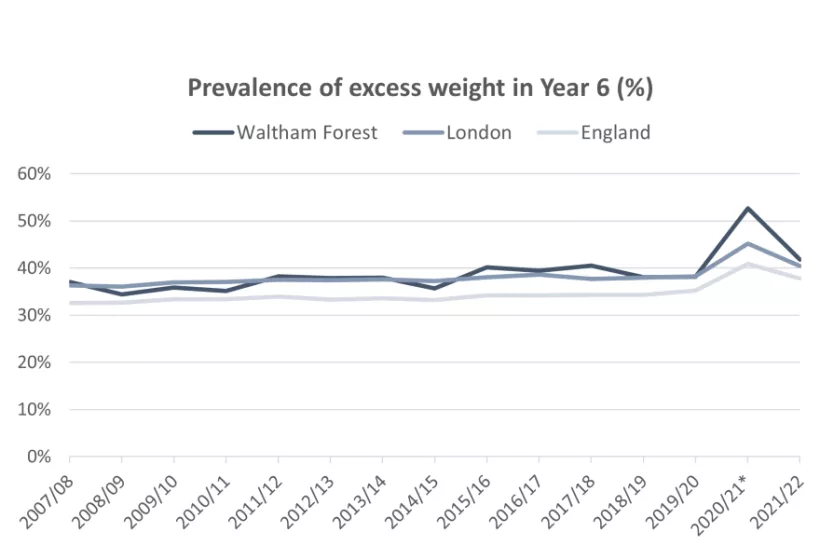Last updated: 21 November 2024
Next review: 21 November 2025
This content is part of the Waltham Forest JSNA. To see other JSNA content, visit the JSNA landing page
Childhood obesity is a concerning issue due to its immediate and long-term impacts. Research has indicated that the chance of overweight or obese children becoming overweight or obese adults increases with age [1, 2, 3]. The longer-term health consequences of childhood obesity include increased risk of conditions such as type 2 diabetes, hypertension and liver disease, as well as the exacerbation of conditions like asthma. Psychological issues such as social isolation, low self-esteem, and experiences of teasing and bullying are also prevalent.
Local rates of childhood overweight and obesity are calculated using data from the National Child Measurement Programme NCMP, which collects height and weight measurements of reception and year six children primarily in mainstream state-maintained schools across England.
The 2019 to 2020 and 2020 to 2021 NCMP data collections were interrupted by the COVID-19 pandemic and should be interpreted with caution. In 2020 and 2021, a representative 10% sample of data was collected to produce national and regional estimates.
Prevalence of overweight, including obesity in Reception year
Based on the 2021 to 2022 National Child Measurement Programme, the data shows that 21.0% of reception-aged children, pupils aged four to five years in Waltham Forest were overweight or living with obesity. This figure is comparable to the national average of 22.3% and the London average of 21.9%.

Source: OHID Public Health Outcomes Framework. Data from National Child Measurement Programme. Date accessed: 13 April 2023.
Note: Data from 2019 to 2020 and 2020 to 2021 should be treated with caution due to the COVID-19 pandemic interrupting with the data collection.
Prevalence of overweight, including obesity in Year 6
By Year 6 pupils aged 10 and 11 years, 41.8% of children were classified as overweight, including obesity. This percentage is similar to the London average. The Waltham Forest rate of overweight in year six has been consistently higher than the national average over the last decade.

Source: OHID Public Health Outcomes Framework. Data from National Child Measurement Programme. Date accessed: 13 April 2023.
Note: Data from 2019 to 2020 and 2020 to 2021 should be treated with caution due to the COVID-19 pandemic interrupting with the data collection.
References:
[1] Guo SS, Chumlea WC 1999. Tracking of body mass index in children in relation to overweight in adulthood. Date accessed: 12 May 2023
[2] Serdula MK, Ivery D, Coates RJ, Freedman DS, Williamson DF, Byers T (1993). Do obese children become obese adults? Date accessed: 12 May 2023
[3] Starc G, Strel J. 2011. Tracking excess weight and obesity from childhood to young adulthood: a 12-year prospective cohort study in Slovenia. Date accessed:12 May 2023